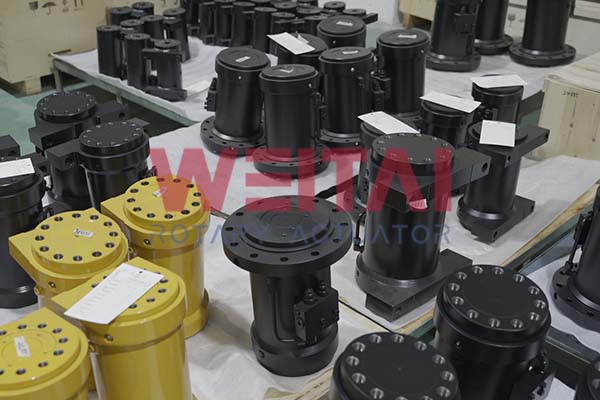When it comes to hydraulic rotating actuators, choosing the right type is crucial for ensuring optimal performance in your machinery or system. Two of the most common types are helical hydraulic actuators and vane hydraulic actuators. Each has unique characteristics that make them suitable for different applications. In this blog post, we’ll dive into the key differences between helical and vane hydraulic rotating actuators, helping you decide which one is the best fit for your needs.

Understanding Hydraulic Rotating Actuators
Hydraulic rotating actuators are devices that convert hydraulic energy into rotational motion. They are used in a wide range of industries, including construction, manufacturing, and marine, to provide precise control over rotational movements. Depending on the application, an actuator may need to generate a specific torque, provide a certain range of rotation, or offer precise control under heavy loads.
Let’s explore the two main types of actuators in more detail.
Helical Hydraulic Rotating Actuators
Helical actuators, also known as helical spline actuators, use a combination of linear and rotational motion to achieve their function. Inside the actuator, a helical screw mechanism converts the linear force generated by hydraulic pressure into rotation. This results in smooth and continuous movement, which is ideal for applications requiring a high degree of precision.
Key Features of Helical Actuators
- High Torque Output: Helical actuators are known for delivering high torque, making them ideal for applications where heavy loads need to be rotated.
- Wide Range of Motion: These actuators can offer both partial and full rotation (up to 360°), providing flexibility in their application.
- Precise Control: Due to the smooth and gradual nature of the helical motion, these actuators provide excellent control, especially in tasks requiring accuracy.
- Durability and Longevity: The robust construction of helical actuators makes them highly durable, suitable for long-term operation in harsh environments.
Common Applications
- Construction Machinery: Helical actuators are used in applications such as excavators, where high torque and precision are essential for lifting and rotating heavy loads.
- Manufacturing Automation: In assembly lines, helical actuators provide the precision needed for tasks like positioning, clamping, and rotating components.
- Aerospace and Defense: The high torque output and accuracy make them ideal for use in missile guidance systems, satellite positioning, and other high-stakes applications.
Vane Hydraulic Rotating Actuators
Vane actuators use a different mechanism to achieve rotation. Inside the actuator, a rotor with vanes is positioned within a chamber. As hydraulic pressure is applied, the vanes move, causing the rotor to rotate. Vane actuators are known for their simple design, high speed, and ability to provide rotation over a limited range.
Key Features of Vane Actuators
- Compact Design: Vane actuators are typically more compact than their helical counterparts, making them ideal for applications where space is limited.
- High Speed: These actuators are known for their fast response time and high rotational speed, making them suitable for applications that require quick movements.
- Limited Range of Motion: Vane actuators are often limited to specific angles of rotation, such as 90°, 180°, or 270°, which makes them ideal for repetitive motions.
- Cost-Effective: Vane actuators are generally less complex and more affordable compared to helical actuators, making them a cost-effective solution for many applications.
Common Applications
- Packaging and Assembly Lines: Vane actuators are used to quickly and efficiently rotate parts or assemblies in tasks like sorting, labeling, and packaging.
- Marine Equipment: In marine steering systems, vane actuators provide the precise movement required to control rudders and other components.
- Material Handling: These actuators are used in conveyor systems and automated handling equipment, where quick and repetitive rotational movements are needed.
Comparing Helical vs. Vane Actuators
| Feature | Helical Actuators | Vane Actuators |
| Torque Output | High torque for heavy-duty applications | Moderate torque for lighter, faster operations |
| Range of Motion | Wide range (up to 360° or more) | Limited range (typically 90°, 180°, or 270°) |
| Speed | Slower but precise rotational movement | Faster, ideal for quick, repetitive motions |
| Durability | Extremely durable and robust | Durable but less so than helical actuators |
| Size and Complexity | Larger and more complex | Compact and simple design |
| Cost | Higher cost due to complexity and materials | More affordable due to simpler construction |
Which One is Right for Your Application?
Choosing between a helical and a vane hydraulic rotating actuator depends largely on the specific needs of your application.
- Choose a Helical Actuator if your application demands high torque, precision, and durability. If you need to rotate heavy loads with a high degree of control, such as in construction machinery, aerospace equipment, or manufacturing systems, a helical actuator is the best option.
- Choose a Vane Actuator if your application requires fast, repetitive rotational movements over a limited range. For tasks that prioritize speed and space efficiency, such as in packaging systems or conveyor lines, a vane actuator is ideal. They are also more cost-effective for applications with lighter load requirements.
Conclusion
Both helical and vane hydraulic rotating actuators offer unique advantages that make them well-suited for different applications. Helical actuators provide the power and precision needed for heavy-duty tasks, while vane actuators excel in compact, high-speed environments with lighter loads.
By understanding the strengths and limitations of each type, you can select the right actuator for your specific needs, ensuring optimal performance and efficiency in your operations. Whether you’re designing industrial machinery, marine equipment, or automated systems, the right hydraulic actuator can make all the difference.
